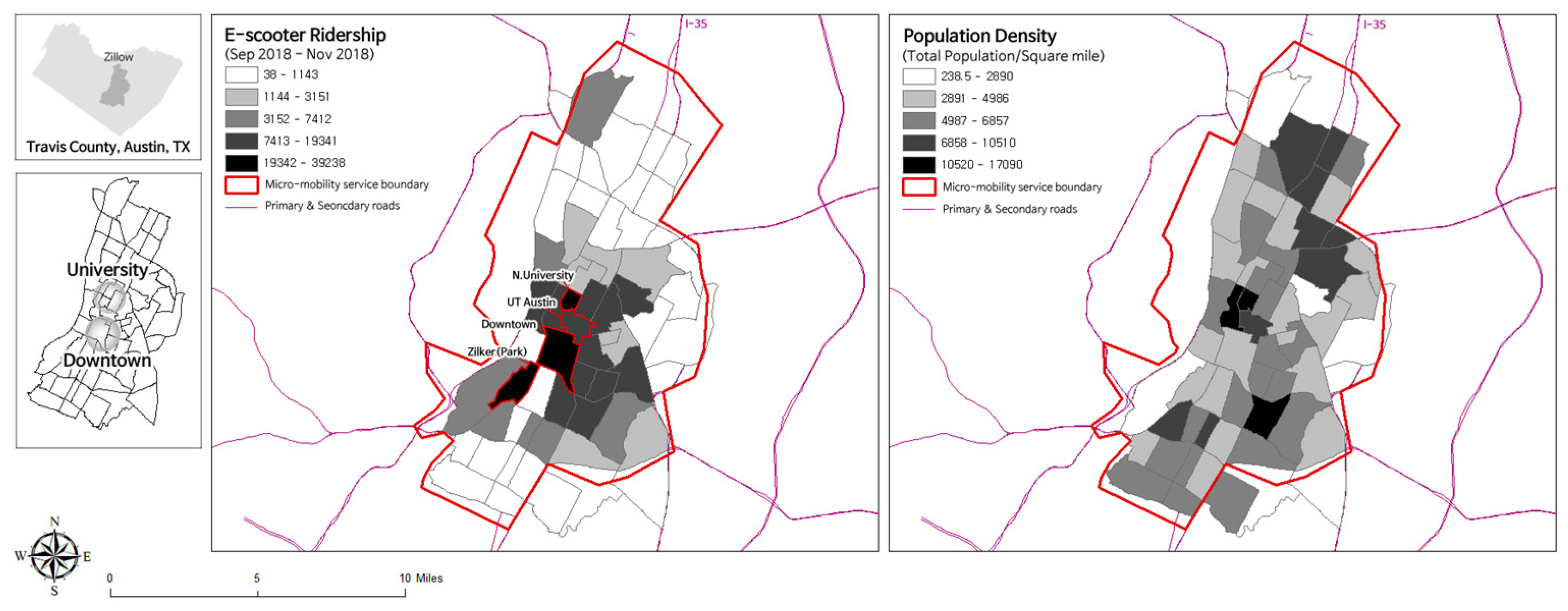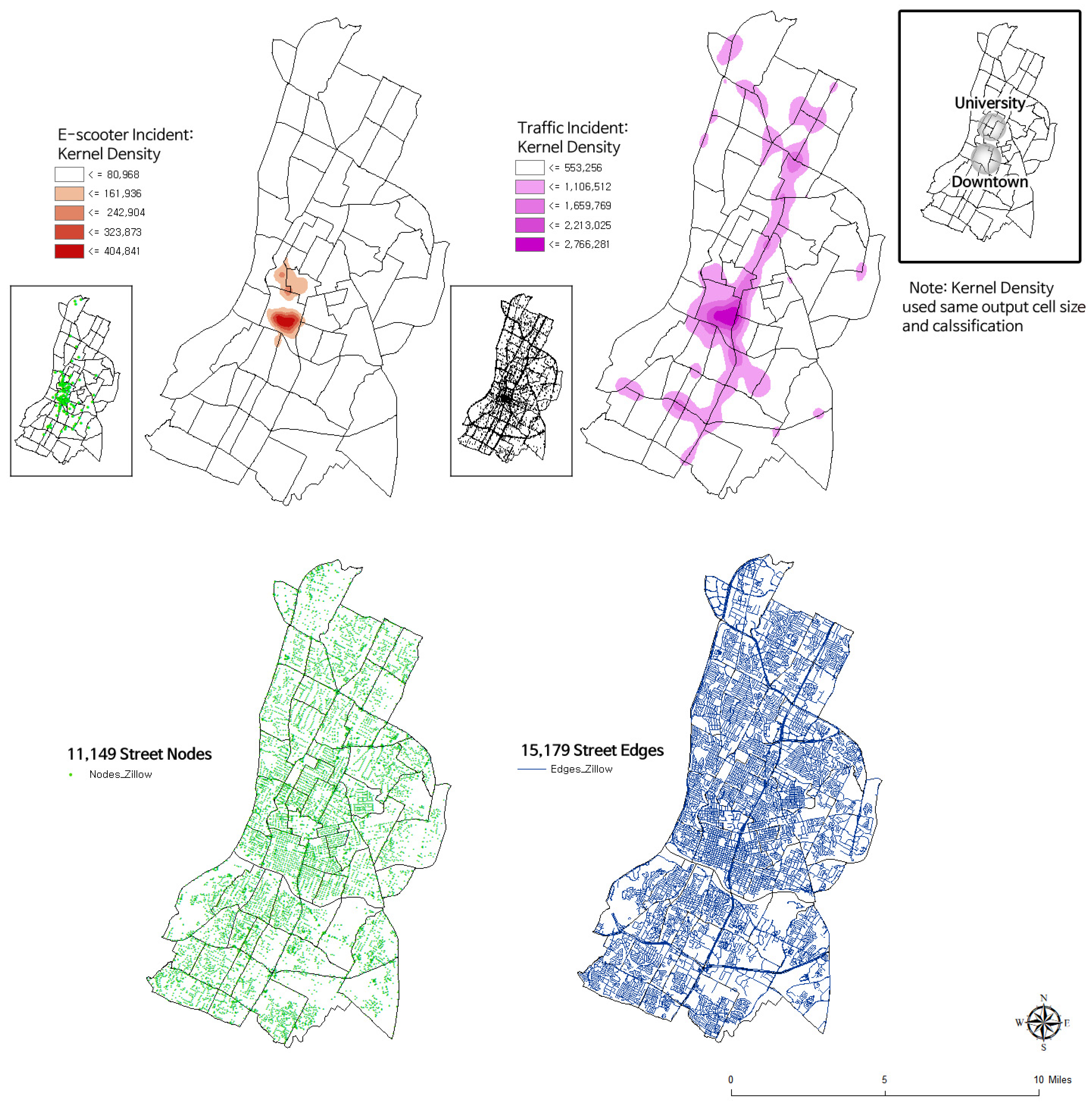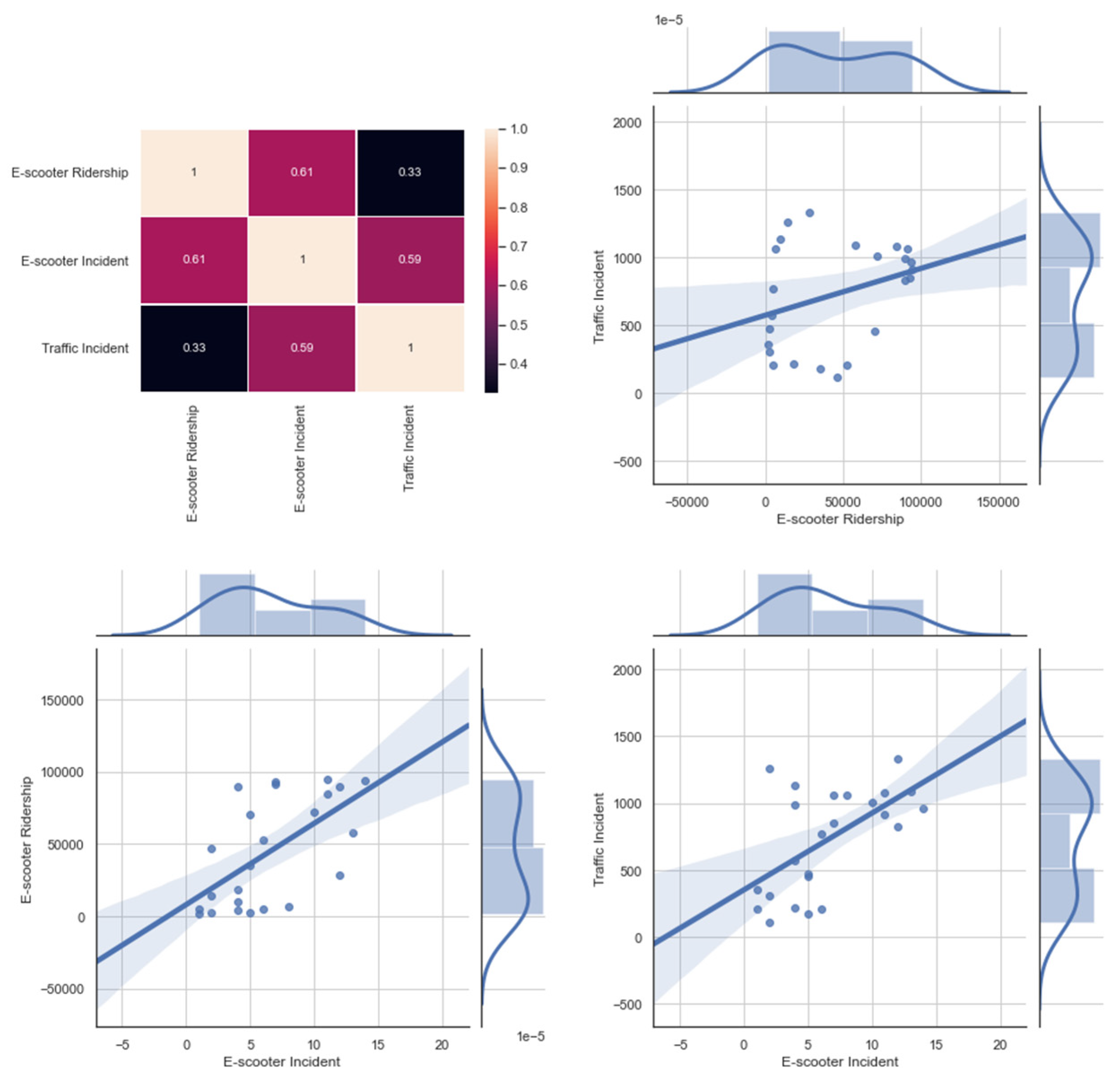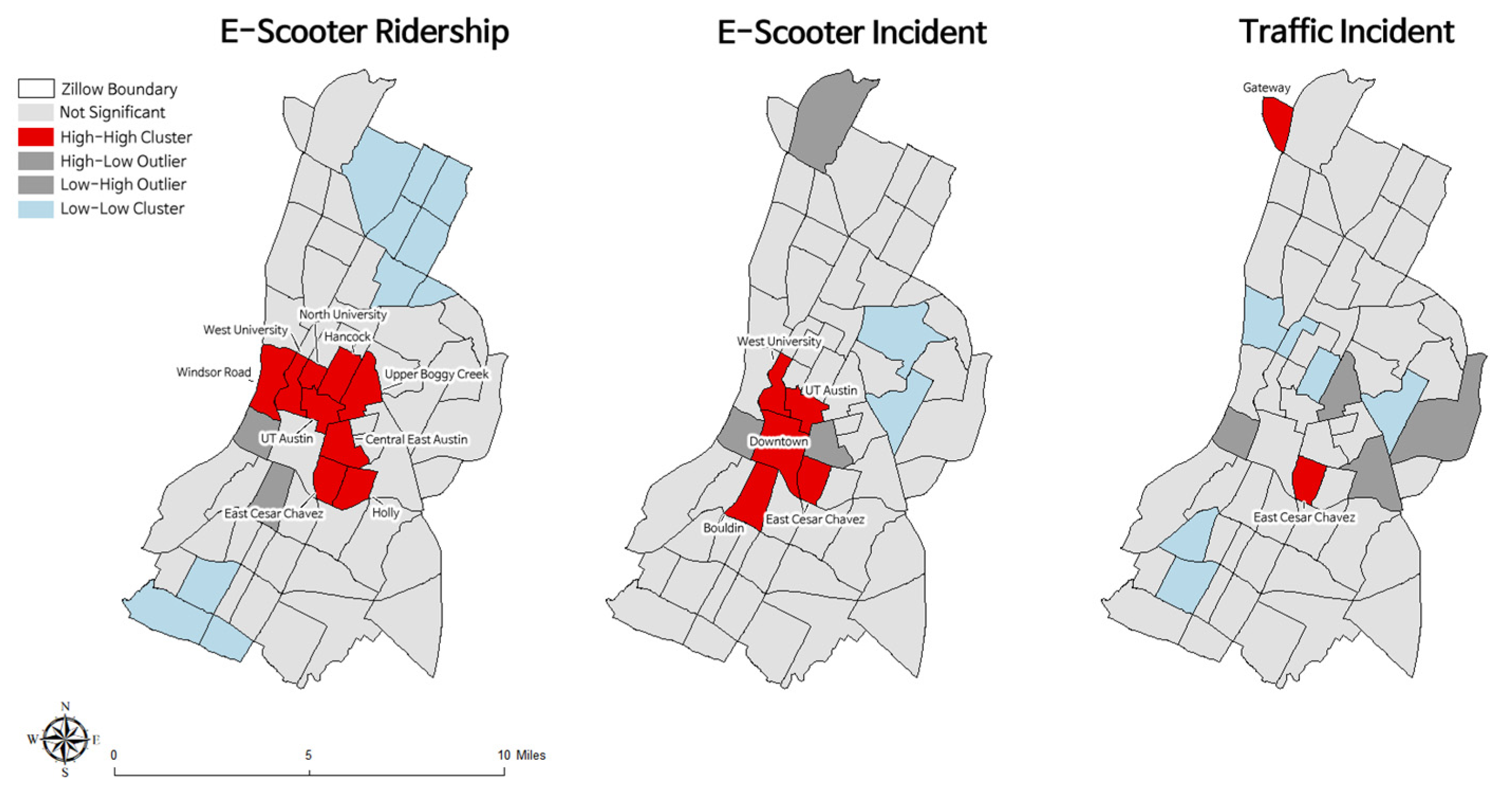Understanding E-Scooter Incidents Patterns in Street Network Perspective: A Case Study of Travis County, Texas
Abstract
:1. Introduction
2. Literature Review
3. Materials and Methods
3.1. Study Area
3.2. Data
3.3. Methods
- : average value of z with the sample number of n,
- : the value of the variable z with all the other location (where ),
- : the variance of variable z,
- : a weight which can be defined as the inverse of the distance between location i and j
- : average of traffic incident associated street network,
- : standard error E-scooter injury associated street network,
- : standard error of traffic incident associated street network,
- : number of E-scooter injury associated street network,
- : number of traffic incident associated street network.
4. Results
4.1. Time Series Analysis
4.2. Local Moran’s I Result
4.3. Independent Z-Test Result
5. Discussion
6. Conclusions
Author Contributions
Funding
Institutional Review Board Statement
Informed Consent Statement
Data Availability Statement
Acknowledgments
Conflicts of Interest
References
- Allem, J.-P.; Majmundar, A. Are electric scooters promoted on social media with safety in mind? A case study on Bird’s Instagram. Prev. Med. Rep. 2019, 13, 62–63. [Google Scholar] [CrossRef]
- Yang, H.; Ma, Q.; Wang, Z.; Cai, Q.; Xie, K.; Yang, D. Safety of micro-mobility: Analysis of E-Scooter crashes by mining news reports. Accid. Anal. Prev. 2020, 143, 105608. [Google Scholar] [CrossRef]
- Bai, S.; Jiao, J. From shared micro-mobility to shared responsibility: Using crowdsourcing to understand dockless vehicle violations in Austin, Texas. J. Urban Aff. 2020, 1–13. [Google Scholar] [CrossRef]
- Shaheen, S.; Cohen, A. Micromobility Policy Toolkit: Docked and Dockless Bike and Scooter Sharing. 2019. Available online: https://escholarship.org/uc/item/00k897b5 (accessed on 4 July 2021). [CrossRef]
- Tuncer, S.; Laurier, E.; Brown, B.; Licoppe, C. Notes on the practices and appearances of e-scooter users in public space. J. Transp. Geogr. 2020, 85, 102702. [Google Scholar] [CrossRef]
- Ma, Q.; Yang, H.; Mayhue, A.; Sun, Y.; Huang, Z.; Ma, Y. E-Scooter safety: The riding risk analysis based on mobile sensing data. Accid. Anal. Prev. 2021, 151, 105954. [Google Scholar] [CrossRef]
- Shah, N.R.; Aryal, S.; Wen, Y.; Cherry, C.R. Comparison of motor vehicle-involved e-scooter and bicycle crashes using standardized crash typology. J. Saf. Res. 2021, 77, 217–228. [Google Scholar] [CrossRef]
- PBOT. 2018 E-Scooter Findings Report; PBOT (Portland Bureau of Transportation): Portland, OR, USA; pp. 1–36.
- Bai, S.; Jiao, J. Dockless E-scooter usage patterns and urban built Environments: A comparison study of Austin, TX, and Minneapolis, MN. Travel Behav. Soc. 2020, 20, 264–272. [Google Scholar] [CrossRef]
- Park, B.; Cho, J. Older adults’ avoidance of public transportation after the outbreak of COVID-19: Korean subway evidence. Healthcare 2021, 9, 448. [Google Scholar] [CrossRef] [PubMed]
- Campisi, T.; Basbas, S.; Skoufas, A.; Akgün, N.; Ticali, D.; Tesoriere, G. The impact of COVID-19 pandemic on the resilience of sustainable mobility in Sicily. Sustainability 2020, 12, 8829. [Google Scholar] [CrossRef]
- Teixeira, J.F.; Lopes, M. The link between bike sharing and subway use during the COVID-19 pandemic: The case-study of New York’s Citi Bike. Transp. Res. Interdiscip. Perspect. 2020, 6, 100166. [Google Scholar] [CrossRef]
- Störmann, P.; Klug, A.; Nau, C.; Verboket, R.D.; Leiblein, M.; Müller, D.; Schweigkofler, U.; Hoffmann, R.; Marzi, I.; Lustenberger, T. Characteristics and injury patterns in electric-scooter related accidents—A prospective two-center report from Germany. JCM 2020, 9, 1569. [Google Scholar] [CrossRef] [PubMed]
- Zou, Z.; Younes, H.; Erdoğan, S.; Wu, J. Exploratory analysis of real-time e-scooter trip data in Washington, D.C. Transp. Res. Rec. 2020, 2674, 285–299. [Google Scholar] [CrossRef]
- Cicchino, J.B.; Kulie, P.E.; McCarthy, M.L. Severity of e-scooter rider injuries associated with trip characteristics. J. Saf. Res. 2021, 76, 256–261. [Google Scholar] [CrossRef]
- Marshall, W.E.; Garrick, N.W. Does street network design affect traffic safety? Accid. Anal. Prev. 2011, 43, 769–781. [Google Scholar] [CrossRef]
- Moeinaddini, M.; Asadi-Shekari, Z.; Zaly Shah, M. The relationship between urban street networks and the number of transport fatalities at the city level. Saf. Sci. 2014, 62, 114–120. [Google Scholar] [CrossRef]
- Dockless Electric Scooter-Related Injuries Study September—November 2018; Austin Public Health: Austin, TX, USA, 2019; pp. 1–15. Available online: https://www.austintexas.gov/sites/default/files/files/Health/Epidemiology/APH_Dockless_Electric_Scooter_Study_5-2-19.pdf (accessed on 21 February 2021).
- Shared Micromobility Vehicle Trips. Open Data. City of Austin Texas n.d. Austin. Available online: https://data.austintexas.gov/Transportation-and-Mobility/Shared-Micromobility-Vehicle-Trips/7d8e-dm7r (accessed on 7 April 2021).
- Scooter Crash Analysis Gives Glimpse of Injuries Toll in Austin. Austin, TX Patch, 2019. Available online: https://patch.com/texas/downtownaustin/scooter-crash-analysis-gives-glimpse-injuries-toll-austin (accessed on 7 April 2021).
- How Cluster and Outlier Analysis (Anselin Local Moran’s I) works—ArcGIS Pro. Documentation, n.d. Available online: https://pro.arcgis.com/en/pro-app/latest/tool-reference/spatial-statistics/h-how-cluster-and-outlier-analysis-anselin-local-m.htm (accessed on 9 September 2021).
- Zhang, C.; Luo, L.; Xu, W.; Ledwith, V. Use of local Moran’s I and GIS to identify pollution hotspots of Pb in urban soils of Galway, Ireland. Sci. Total Environ. 2008, 398, 212–221. [Google Scholar] [CrossRef]
- Lu, X.; Wang, M.; Tang, Y. The spatial changes of transportation infrastructure and its threshold effects on urban land use efficiency: Evidence from China. Land 2021, 10, 346. [Google Scholar] [CrossRef]
- Moons, E.; Brijs, T.; Wets, G. Improving Moran’s Index to identify hot spots in traffic safety. In Geocomputation and Urban Planning; Murgante, B., Borruso, G., Lapucci, A., Eds.; Springer: Berlin/Heidelberg, Germany, 2009; pp. 117–132. [Google Scholar] [CrossRef] [Green Version]
- Truong, L.; Somenahalli, S. Using GIS to identify pedestrian-vehicle crash hot spots and unsafe bus stops. JPT 2011, 14, 99–114. [Google Scholar] [CrossRef] [Green Version]
- Kuo, P.-F.; Zeng, X.; Lord, D. Guidelines for choosing hot-spot analysis tools based on data characteristics, network restrictions, and time distribustions. In Proceedings of the Transportation Research Board 91st Annual Meeting, Washington, DC, USA, 22–26 January 2012. [Google Scholar]
- Xie, Z.; Yan, J. Detecting traffic accident clusters with network kernel density estimation and local spatial statistics: An integrated approach. J. Transp. Geogr. 2013, 31, 64–71. [Google Scholar] [CrossRef]
- Jiao, J.; Moudon, A.V.; Drewnowski, A. Grocery shopping: How individuals and built environments influence choice of travel mode. Transp. Res. Rec. 2011, 2230, 85–95. [Google Scholar] [CrossRef] [Green Version]
- Solgi, E.; Oshvandi, Z. Spatial patterns, hotspot, and risk assessment of heavy metals in different land uses of urban soils (case study: Malayer city). Hum. Ecol. Risk Assess. 2018, 24, 256–270. [Google Scholar] [CrossRef]
- Martin, E.; Cohen, A.; Botha, J.; Shaheen, S. Bikesharing and bicycle safety. MTI Publ. 2016, 1204, 93. [Google Scholar]





| Variable | Unit | Count | Mean | Std | Min | Max | |
|---|---|---|---|---|---|---|---|
| Land Use and Built Environment (COA, 2012) | Residential | ratio | 1566 | 0.432 | 0.286 | 0.000 | 0.916 |
| Commercial | ratio | 1566 | 0.080 | 0.126 | 0.000 | 0.668 | |
| Office | ratio | 1566 | 0.041 | 0.094 | 0.000 | 1.000 | |
| Industrial | ratio | 1566 | 0.033 | 0.101 | 0.000 | 0.807 | |
| Public | ratio | 1566 | 0.051 | 0.115 | 0.000 | 0.863 | |
| OpenSpace | ratio | 1566 | 0.033 | 0.087 | 0.000 | 0.827 | |
| Transportation Related | ratio | 1566 | 0.011 | 0.040 | 0.000 | 0.443 | |
| Street Edges (Zillow, 2017) | Length | meter | 1566 | 168.636 | 131.382 | 3.560 | 1015.575 |
| One-way | dummy * | 1566 | 0.159 | 0.366 | 0.000 | 1.000 | |
| Link | dummy * | 1566 | 0.028 | 0.165 | 0.000 | 1.000 | |
| Living Street | dummy * | 1566 | 0.001 | 0.025 | 0.000 | 1.000 | |
| Motorway | dummy * | 1566 | 0.011 | 0.104 | 0.000 | 1.000 | |
| Primary | dummy * | 1566 | 0.050 | 0.218 | 0.000 | 1.000 | |
| Residential | dummy * | 1566 | 0.538 | 0.499 | 0.000 | 1.000 | |
| Secondary | dummy * | 1566 | 0.205 | 0.404 | 0.000 | 1.000 | |
| Territory | dummy * | 1566 | 0.000 | 0.000 | 0.000 | 0.000 | |
| Trunk | dummy * | 1566 | 0.003 | 0.056 | 0.000 | 1.000 | |
| Unclassified | dummy * | 1566 | 0.010 | 0.101 | 0.000 | 1.000 | |
| Street Nodes (Zillow, 2017) | Total Nodes | count | 1566 | 2.334 | 2.495 | 0.000 | 27.000 |
| Motorway Junction | count | 1566 | 0.033 | 0.179 | 0.000 | 1.000 | |
| Traffic Signal | count | 1566 | 0.131 | 0.337 | 0.000 | 1.000 | |
| Turning Circle | count | 1566 | 0.050 | 0.219 | 0.000 | 1.000 | |
| Stop Sign | count | 1566 | 0.003 | 0.050 | 0.000 | 1.000 | |
| Variable | Unit | Source | Year | |
|---|---|---|---|---|
| Crash | E-scooter | Count | Patch | 2018 |
| Traffic Incident | Count | COA | 2018 | |
| Ridership | E-scooter | Count | COA | 2018 |
| Study Period: September–November 2018 | ||||
| Variable | Z | p | |
|---|---|---|---|
| Land Use and Built Environment | Residential | −2.5842 | 0.0098 ** |
| Commercial | 0.5699 | 0.5687 | |
| Office | 0.8311 | 0.4059 | |
| Industrial | −0.1635 | 0.8701 | |
| Public | 0.6657 | 0.5056 | |
| OpenSpace | 0.1480 | 0.8824 | |
| Transportation Related | 0.5043 | 0.6140 | |
| Street Edges | Length | −1.60 × 102 | 0.0000 *** |
| One-way | 1.5768 | 0.1148 | |
| Link | 0.0701 | 0.9441 | |
| Living Street | 0.0779 | 0.9379 | |
| Motorway | 0.0329 | 0.9737 | |
| Primary | 2.1168 | 0.0343 * | |
| Residential | −2.9462 | 0.0032 ** | |
| Secondary | 0.1256 | 0.9001 | |
| Territory | 0.0000 | 1.0000 | |
| Trunk | −0.041 | 0.9673 | |
| Unclassified | 0.4718 | 0.6371 | |
| Street Nodes | Total Nodes | 17.4173 | 0.0000 *** |
| Motorway Junction | 0.0906 | 0.9278 | |
| Traffic Signal | 4.7794 | 0.0000 *** | |
| Turning Circle | −0.3029 | 0.7620 | |
| Stop Sign | 0.3117 | 0.7553 | |
Publisher’s Note: MDPI stays neutral with regard to jurisdictional claims in published maps and institutional affiliations. |
© 2021 by the authors. Licensee MDPI, Basel, Switzerland. This article is an open access article distributed under the terms and conditions of the Creative Commons Attribution (CC BY) license (https://creativecommons.org/licenses/by/4.0/).
Share and Cite
Jiao, J.; Bai, S.; Choi, S.J. Understanding E-Scooter Incidents Patterns in Street Network Perspective: A Case Study of Travis County, Texas. Sustainability 2021, 13, 10583. https://doi.org/10.3390/su131910583
Jiao J, Bai S, Choi SJ. Understanding E-Scooter Incidents Patterns in Street Network Perspective: A Case Study of Travis County, Texas. Sustainability. 2021; 13(19):10583. https://doi.org/10.3390/su131910583
Chicago/Turabian StyleJiao, Junfeng, Shunhua Bai, and Seung Jun Choi. 2021. "Understanding E-Scooter Incidents Patterns in Street Network Perspective: A Case Study of Travis County, Texas" Sustainability 13, no. 19: 10583. https://doi.org/10.3390/su131910583
APA StyleJiao, J., Bai, S., & Choi, S. J. (2021). Understanding E-Scooter Incidents Patterns in Street Network Perspective: A Case Study of Travis County, Texas. Sustainability, 13(19), 10583. https://doi.org/10.3390/su131910583







